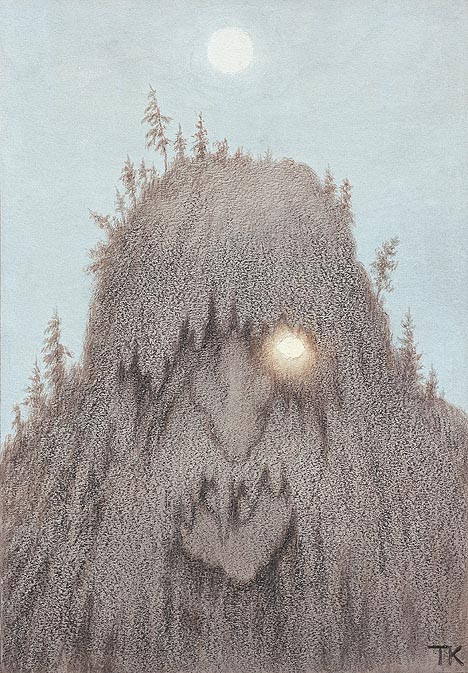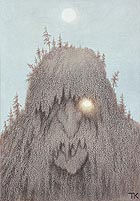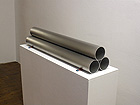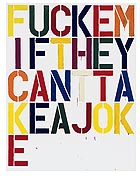
translated and summarized by: Liz Wollner-Grandville,
English summaries December 7 - 13
Leopold Museum: Edvard Munch and the Uncanny
The Leopold Museum dedicated its fall exhibition to the presentation of the “uncanny”. Posters showing Munch’s work “Angst” (1894) lure the audience into the exhibition “Edvard Munch and the Uncanny”.
The paintings depict everything could conceivably threaten human existence: emotional and physical sickness, poverty, death and the devil, figures from the next world and mythology. Ghosts and wild animals emerge from the background and hassle mankind.
Alongside Munch, the exhibition includes works by Ensor and Kubin as well as other renowned artists known for their depictions of the uncanny. Among them Goya’s “The Sleep of Reason Produces Monsters” from Los Caprichos, as well as Piranesi’s “Carceri”, and – in an immediate comparison – variations by Kubin, Kittelsen and Laerman. Daumier, Gauguin, Klinger, Klimt, Schiele and his teacher Griepenkerl, Jettmar, Böcklin, Füssli, Gabriel von Max, Khnopff and Victor Hugo, as well as a few Italians: they all deal with masquerade, with nightmares in the form of fantasy creatures, with occultism, with the plague, syphilis, insanity and the horrors of war. The “Tree of the hanged” by the Italian Barzagni stands for the “uncanny home”: from far away and at first sight it depicts a beautiful Christmas tree and only a closer look reveals a seemingly idyllic ambience of abysmal cynicism of an Italian patriot compared to a pacifist.
Thanks to the way the works are arranged, the plethora of 200 paintings as well as the subject becomes manageable. Since the exhibition does not offer a “Happy End”, a distanced and reflected viewing of the happenings on the wall is recommended.
By the way, there are references for suitable music on the walls. Care for an example? For death and devil “Danse macabre” by Camille Saint-Saens.
By Maria-Gabriela Martinkowic
Leopold Museum
1070 Vienna, MuseumsQuartier until 18.01.10
www.leopoldmuseum.org
Projektraum Viktor Bucher: Michael Kienzer vs. Markus Wilfling
The ultimate exchange of blows
How will these two heavyweight champions of transcendent structures challenge each other this time?
Wilfling starts by exchanging the space of common perception into one that could easily vanish by implementing an oversized “ceiling plug”.
Michael Kienzer strikes back with “Sketch Vol. 14”, a sculpture of three aluminium tubes mounted on top of each other, blocked by four red-and-blue erasers. His restriction of fundamental forces remind of Johannes Kepler’s laws of planetary motion. But for Kienzer they all seem to accelerate in one direction and are simultaneously frozen matter.
Wilfling strikes back with a variation of his “Alibert” series. This time the bathroom cupboard is dissected into 8 parts, all leaning towards one another like books.
Then Kienzer takes the lead with his “Leitwerk”: another assembly of aluminium-tube modules with an upright plate in the middle, demonstrating the natural endeavour towards highest possible symmetry. Wilfling parries with two equally sized, intertwined and tilted iron window frames (250 x 50 x 50 cm), which stabilize each other in an elegant balancing act of seeming motion. Thereby his “steles” dancingly overcome gravity, while Kienzer’s sculpture has hit the ground.
Wilfling successfully sets his next blow with the iron gridded wall, which divides the large exhibition space. As mathematical grids can be transformed into circles, and the principle of the close-packing of spheres is deductible from the densest grid pack, the artistic equation Kienzer=Wilfling could result at this stage.
If a grid represents the sum of all integral linear combinations of independent points in an n-dimensional Euclidean room, then the light reflected, mirrored and doubled by the grid profile makes that these lines visible.
Behind the grid wall Kienzer placed a useless chair stacked with pressboards by. The pressure of the upper, vertical boards stabilize the lower, horizontal boards, while in his wall sculpture “O.O” two aluminium-circles – above and below a ledge and framed only by a rubber band, are balanced as if floating. Is this the living room of a society living in hermetic illusion, whose critical mass could easily skid?
The final exchange of blows takes place in the storeroom:
Kienzer writes the words “ephemeral” and “still” in superimposed, multilayered letters in glass cases mounted on the wall. This is accompanied by a video showing a gnat dancing against the glass wall; power lines in the background. This barrier goes beyond its 400 million years of reality, against which die 40.000 years of the Homo sapiens seem ephemeral. The artificial and hostile illusion, which has evolved into matter and blocks her way into the future, let her fail miserably – and Kienzer’s words become the portent for the upcoming collective knock-out.
By Renate Quehenberger
Projektraum Viktor Bucher
1020 Vienna, Praterstrasse 13/1/2, until 15.01.10
www.projektraum.at
MUMOK Museum moderner Kunst: Gender Check – Role Models in Eastern European Art
Don’t be afraid of Soz-Art
Bojana Pejic and a team of experts compiled an exceptionally diverse collection with 400 works by 200 artists for the exhibition “Gender Check. Role Models in Eastern European Art” at the MUMOK. When asked if she did not consider the amount of art to be an overload, Pejic countered with the question if one was afraid of so much art.
One thing one can definitely say about the huge show is that one has rarely seen so many, until recently largely unknown, positions, spanning across numerous generations. It was a clever decision to present artists supported by the regime as well as “unofficial” artists: an adequate overview of art spanning over the past five decades is only possible if Soz-Art, the art movement founded in the Soviet Union at the beginning of the 1970’s, is included in the dialogue.
The exhibition manages to present the diverse approaches to the topic without any finger-wagging. Paintings expounding the problems of females during the seemingly equality-minded communism, show that works by artists, especially female artists, who were respected by communism, were not necessarily loyal to the regime.
There is enough space for many topics in this extensive show: Mother roles (Katarzyna Górna, Anna Kovshar, Ieva Iltnere), homosexuality (Jaroslaw Modzelewski and Marek Sobczyk, Marju Mutsu), pornography (Jelen Radic, Eva Filová, Anetta Mona Chisa and Lucia Tkácová), violence (Ágnes Szépfalvi, Rovena Agolli) female images (Sanja Ivekovic, Margit Anna, as well as, more important, male depictions (Zaneta Vangeli, Dren Maliqui, Jana Zelibská).
As doubtful as exhibitions combining art from certain regions may be, focussing on gender roles makes the geographical narrowing-down reasonable; after all: the story of genders was very different in the communist East to that in the capitalist West. On account of the size of this exhibition, the MUMOK should seriously consider issuing a general pass – one visit will definitely not suffice to see the entire show.
By Nina Schedlmayer
MUMOK Museum moderner Kunst
1070 Vienna, MuseumsQuartier, until 14.02.10
www.mumok.at
Kunsthaus Graz: Screening Real. Conner Lockhart Warhol / Warhol – Wool – Newman: Painting Real
Andy Warhol town
This autumn’s highlight in Graz: a two-part exhibition with works by Andy Warhol, the 20th century star artist. Merging a Warhol-exhibition with contemporaneous works by artist colleagues as well as artists, who are still active today, is a successful endeavour. The ambition to rewrite art history, in an attempt to confirm Newman’s direct influence on Warhol’s works, is a strong one.
“Screening Real” is integrated into the program of this year’s “Steirischer Herbst” and is worthwhile seeing. The videos by Sharon Lockhart, who stages the social environment of the working class in her familiar solid way, contrast the works by Bruce Conner and Andy Warhol. The evolution of film, respectively video, is shown in an artistic context. And how often does one have the opportunity to see Warhol’s films “Screen Tests” (1964-66), “Eat”(1964), “Sleep” (1963) and “Kiss” (1963)?
The parallel show “Painting Real” presents an overview of Warhol’s early works - before the attempt on his life in 1968. The technique of silk-screen painting offered Warhol a wide spectrum of production possibilities. Works by Barnett Newsman and Christopher Wool are juxtaposed with those of Warhol. Newman’s large format paintings once roused excitement, and Wool’s Word Paintings visualize what is usually executed with print technology, but – when painted - attain a different meaning with respect to talent, art, and handicraft.
By Nora Theiss
Kunsthaus Graz
8020 Graz, Lendkai 1, until 10.01.10
www.kunsthausgraz.at
Mehr Texte von translated and summarized by: Liz Wollner-Grandville


 Teilen
Teilen





